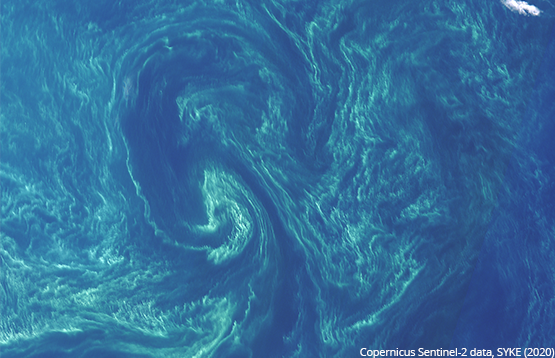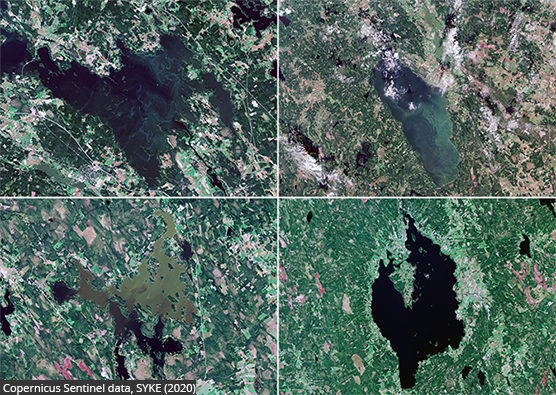Press release 2020-08-20 at 12:50

Detail of the blue-green algae bloom of Bothnian Sea, detected by the Sentinel-2 satellite on 18th of August 2020. Contains modified Copernicus data, SYKE (2020). See more in the
TARKKA web map application.
Cyanobacterial surface accumulations in open sea areas of the Gulf of Finland and the Bothnian Sea are still visible in satellite images, even though they are less intensive than earlier. In coastal and archipelago areas, the observations of cyanobacteria are more abundant than average for the season. In lakes, warm weather has increased cyanobacteria at some sites, but the observations of cyanobacteria are in most regions still fewer than average for the season.
Read more in Finnish

During the summer, cyanobacteria have also been observed from several lakes using satellites. The cyanobacteria can be seen as green swirls of different shades or as a green mass in the images. From the Sentinel-2 satellite image of 18th of August 2020 cyanobacteria were detected e.g. on
Vanajavesi in Hämeenlinna (top row left),
Pyhäjärvi and Köyliönjärvi in Säkylä (top row right) and
Evijärvi (bottom row left). For comparison, there is a picture of Lake
Lappajärvi (bottom right) where no cyanobacteria have been observed. Contains modified Copernicus data, SYKE (2020). See more in the
TARKKA web map application.
Report your algal bloom observations to the Järvi-meriwiki (Lake and sea wiki)
In the Järvi-meriwiki maintained by the Finnish Environment Institute, everyone has the opportunity to establish their own observation site and share algal bloom observations from lakes and coastal areas. Individual observations can also be sent while navigating different water bodies. You can also report observations using the smartphone-friendly Havaintolähetti website. The reported observations are shown on the national algal situation map, and they support the national algal situation assessment. Observations about the absence of cyanobacteria are also important.
Järvi-meriwiki is an online service produced in collaboration with authorities and citizens. The service provides basic information on all lakes larger than one hectare as well as different areas of the Baltic Sea. Users can share, for example, photos and other observations on the service.
Municipalities and cities monitor the cyanobacterial situation on the beaches, so it is advisable to report rich cyanobacterial blooms on beaches to the health authorities of the municipality in question.
Cyanobacteria observations also in the Itämeri.fi service
This summer, a website on algal bloom observations on the Itämeri.fi service is also launched. The cyanobacterial map presented on this algal bloom observations page combines the observations reported to the Järvi-meriwiki and from the beaches of the City of Helsinki as well as the observations based on satellite interpretations of the Finnish Environment Institute during the last three days.
This is how you identify cyanobacteria
A small amount of cyanobacteria in the water appears as green or yellowish particles. Narrow stripes of algae can drift to a beach. In calm weather, a substantial amount of cyanobacteria forms greenish or yellowish algal rafts and piles up in coastal water. Unlike cyanobacteria, pollen is found not only on the surface water but also, for example, on piers or yard furniture.
If the algae dissolve into tiny particles in the water when you touch it with a stick, it may be cyanobacteria. If the algae attache to the stick, it is something other than cyanobacteria. In a glass of water, cyanobacteria rise to the surface as tiny greenish particles within about an hour.
Algae bloom risk analysis
The risk of cyanobacterial blooms in the Finnish sea areas is considerable or moderate – the summer weather determines the actual situation (Press release June 4, 2020)
Information about algae situation
More information
(Telephone 1.00 - 3.00 pm)
Lakes
- Senior Research Scientist Kristiina Vuorio, Finnish Environment Institute SYKE, Tel. +358 295 251 757, firstname.lastname@ymparisto.fi
Sea areas
Cyanobacterial bloom situation
- Senior Research Scientist Sirpa Lehtinen, Finnish Environment Institute SYKE, Tel. +358 295 251 353, firstname.lastname@ymparisto.fi
State of the Baltic Sea
-
Research Professor Markku Viitasalo, Finnish Environment Insitute SYKE, Tel. +358 295 251 742, firstname.lastname@ymparisto.fi (until 21/08)
-
Leading Researcher Harri Kuosa Finnish Environment Insitute SYKE, Tel. +358 295 251 106, firstname.lastname@ymparisto.fi (from 24/08)
Communications
- Communications Intern Iris Aarola, Finnish Environment Institute SYKE, Tel +358 295 252 189, firstname.lastname@ymparisto.fi